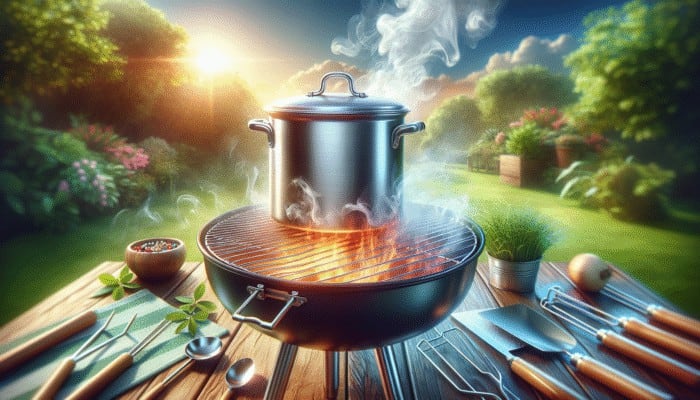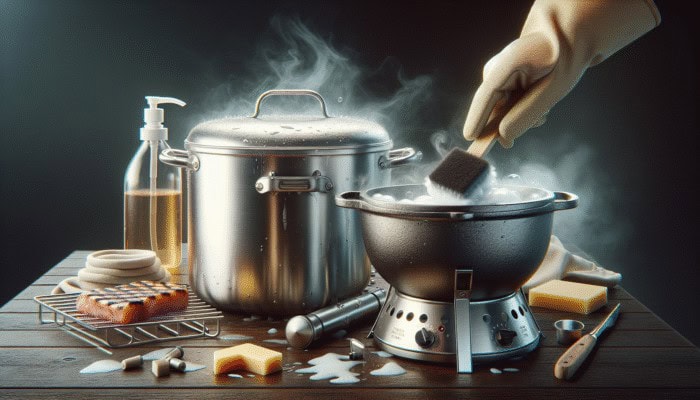Expert Techniques for Selecting the Perfect Smoker Pot for Your Compact Grill
Choosing the ideal smoker pot is vital for creating an exceptional barbecue experience, particularly when utilising a small grill. The right smoker pot not only enriches the flavour profile of your grilled dishes but also integrates seamlessly with the practical aspects of your grilling setup. To simplify your decision-making amidst the plethora of options available, focus on essential factors such as material, size, reputable brands, and vital maintenance practices. By prioritising these elements, you ensure that your smoker pot effectively enhances your grilling sessions, allowing you to relish in the delectable flavours of expertly smoked meals.
Discovering the Most Suitable Materials for Your Smoker Pot

The durability and functionality of your smoker pot are significantly influenced by the materials used in its construction. Many grilling aficionados favour stainless steel due to its extraordinary resistance to rust and corrosion, ensuring that your smoker pot will last through multiple grilling seasons. Additionally, stainless steel boasts excellent heat retention, which is essential for generating the perfect smoke required to infuse flavours during cooking.
Another remarkable choice is cast iron, a time-honoured material renowned for its superb heat distribution. Its ability to conduct heat evenly makes it an exceptional option for smoking, yielding consistently impressive results. Although cast iron may require more maintenance, including regular seasoning to prevent rust, the depth of flavour it imparts to your meats is unmatched. When utilising a smoker pot for small grills, focusing on durability and heat resistance will enable you to explore a variety of smoking techniques and wood types, significantly enhancing your grilling adventures.
Understanding the Importance of Size When Choosing Your Smoker Pot
For those employing small grills, the size of your smoker pot is a crucial factor that can dramatically affect your cooking outcomes. It is vital to select a smoker pot that fits comfortably within your grill without obstructing airflow or consuming excessive space. An overcrowded grill can result in uneven cooking and insufficient smoke circulation, both of which can detrimentally impact your barbecue experience.
A smoker pot with a diameter of approximately 5 to 7 inches is generally ideal for most compact grills, including popular models from Weber and Char-Broil. This size allows for a generous quantity of wood chips while keeping your grilling surface functional. Remember that a well-placed smoker pot optimises your grill's capabilities. Striking a balance between efficiency and functionality is crucial for enhancing your grilling process while enjoying the rich flavours derived from utilising a smoker pot for small grills.
Top Brands to Consider for Quality Smoker Pots
In the sphere of outdoor cooking, a brand's reputation can significantly influence your experience with using a smoker pot for small grills. Opting for established brands like Weber or Char-Broil ensures that you are investing in high-quality products, backed by positive customer feedback derived from rigorous testing and reliable performance.
Weber is renowned for its innovative approach to grilling technology, offering smoker pots that seamlessly integrate with their small grill designs. Often, these smoker pots incorporate advanced engineering that promotes optimal smoke generation and enhances flavour infusion. Char-Broil, in contrast, provides a range of durable, budget-friendly options that maintain high performance standards. Always seek user reviews and warranties that indicate a brand's commitment to quality and customer satisfaction, as these elements can greatly enhance your grilling experience.
Essential Maintenance Tips to Ensure Your Smoker Pot Performs Optimally

Regular maintenance of your smoker pot is critical for guaranteeing a smooth grilling experience. Cleaning should be conducted after each use to prevent residue buildup that could adversely affect the flavour of future dishes. For stainless steel pots, a mixture of warm soapy water and a non-abrasive scrubber is usually sufficient. Meanwhile, cast iron may require a more thorough seasoning process to maintain its non-stick properties.
Be vigilant for signs of rust or damage, as addressing these issues proactively can significantly prolong the lifespan of your smoker pot. A well-maintained smoker pot not only ensures safe cooking but also enhances the overall flavour profile of your grilled meals, making your efforts in using a smoker pot for small grills immensely rewarding.
Do You Prefer Listening to Content Instead of Reading?
Preparing Your Smoker Pot for Peak Performance in Grilling
Preparation is a fundamental step before you delve into the smoking process. Thoughtfully selecting your wood chips, adequately soaking them, and mastering the filling techniques can significantly influence the outcome of your grilling session. When utilising a smoker pot for small grills, these preparatory measures are essential for achieving the rich, smoky flavours that make barbecued dishes so irresistible.
Selecting Wood Chips for an Exquisite Smoking Experience
The selection of wood chips is pivotal for your smoking journey, as various types impart distinct flavours to your grilled foods. For instance, hickory offers a robust, bacon-like flavour that pairs exceptionally well with meats like brisket and ribs. Conversely, if you prefer a milder flavour profile, applewood delivers a sweet, fruity smoke that complements poultry and vegetables beautifully.
When choosing wood chips, consider the specific type of food you are preparing. Experimentation is encouraged; combining different wood types can yield surprisingly delightful results. For instance, blending hickory with cherry wood can create a complex flavour that enhances the natural tastes of your ingredients. By carefully selecting your wood chips, you ensure that your experience using a smoker pot for small grills transforms into a culinary adventure filled with rich and inviting aromas.
Why Soaking Wood Chips is Essential for Optimal Smoke Production

Soaking your wood chips is a vital step that many novice grillers often overlook. By immersing the chips in water for at least 30 minutes, you allow them to absorb moisture, which promotes a slow smouldering process rather than a rapid burn. This soaking procedure is invaluable as it helps generate thick clouds of smoke, enriching your food with flavour over an extended period.
For those eager to experiment, consider soaking your chips in alternative liquids such as apple juice, beer, or even wine to impart unique flavours to the smoke. The key is to achieve a balance; while you want the chips to smoulder, they should not become overly saturated, as this can hinder the smoking process. Properly soaked wood chips are instrumental when utilising a smoker pot for small grills, ensuring that your food is infused with the nuanced flavours you desire.
How to Fill Your Smoker Pot Effectively for Optimal Results
Filling the smoker pot requires a bit of finesse and understanding to achieve the best results. After soaking, drain the wood chips and fill the pot, leaving some space at the top. This space is crucial as it allows the chips to expand when heated and guarantees adequate airflow. A smoker pot that is overstuffed can lead to uneven burning, resulting in inconsistent smoke production.
Aim for a fullness level that promotes optimal smoke generation without risking overflow or blockage. Once the smoker pot is filled, you are prepared to embark on your smoking journey. The meticulous preparation of your smoker pot lays the groundwork for an unforgettable grilling experience, one that embodies the essence of using a smoker pot for small grills.
Setting Up Your Grill for Exceptional Smoking Success
The setup process is where your careful preparations converge into a delicious reality. Proper grill preparation, strategic positioning of your smoker pot, and diligent temperature control are all essential components that dictate the success of your smoking endeavour.
Thoroughly Preparing Your Grill for Outstanding Results
A clean grill is vital for achieving superior cooking outcomes. Before you embark on your smoking journey, ensure that your grill grates are free from any residual food particles, grease, or char. This not only enhances the flavour of your smoke but also facilitates even cooking. A dirty grill can lead to flare-ups, which counteract the low-and-slow smoking method you’ll be employing.
Set your grill to a low heat setting, ideally between 225°F and 250°F. This temperature range is optimal for smoking, allowing smoke to adhere to the food without cooking it too swiftly. Different grills may vary in their heat retention and distribution, so it is important to familiarise yourself with your grill’s specific characteristics. A well-prepared grill serves as the foundation upon which you will build a memorable experience utilising a smoker pot for small grills.
Strategically Positioning Your Smoker Pot for Enhanced Flavour Infusion
The strategic placement of the smoker pot is crucial for maximising flavour infusion while maintaining a steady cooking temperature. Depending on your grill type, you can place the smoker pot directly on the grill grates or utilise a heat deflector to shield it from direct flames. The goal is straightforward: you want the smoke to circulate evenly around the food without exposing it to direct high heat.
Take the time to ensure that the smoker pot is stable and secure in its position, as any movement could disrupt airflow and lead to inconsistent smoking. With the smoker pot correctly positioned, you’re one step closer to achieving the smoky perfection that embodies the art of using a smoker pot for small grills.
Mastering Temperature Control for Consistent Smoking Results
Monitoring the grill temperature is an ongoing task that demands your attention and expertise. Aim to maintain a smoking temperature between 225°F and 250°F, as this range provides the perfect balance of heat and smoke. Investing in a reliable grill thermometer is highly recommended, as it will provide accurate readings and enable you to make necessary adjustments to stay on track with your cooking.
The vents on your grill are crucial for regulating temperature. By adjusting airflow, you can either increase or decrease the heat, ensuring that you remain within the ideal smoking range. Mastering temperature control is essential, as it distinguishes a mediocre smoking experience from one that results in tender, flavourful, and succulent dishes. This focus on temperature management will significantly enhance your journey using a smoker pot for small grills.
Advanced Smoking Techniques to Elevate Your Grilling Experience
When it comes to smoking, mastering techniques is just as important as possessing the right equipment. The art of using a smoker pot for small grills encompasses various methods that can elevate your grilling game, ensuring rich flavours and satisfying outcomes.
Implementing the Indirect Heat Method for Even Cooking
The indirect heat method is fundamental to smoking techniques, particularly when working with small grills. By placing your food away from direct contact with the smoking pot, you promote even cooking and prevent excessive charring. This approach focuses on surrounding the food with a gentle flow of smoke and heat, creating the ideal environment for flavour infusion.
To effectively implement this technique, arrange your charcoal on one side of the grill while positioning the smoker pot on the opposite side. Place your food on the cooler side, allowing it to absorb the flavours of the smoke without being exposed to the harshness of direct heat. This method works exceptionally well for larger cuts of meat, such as briskets or pork shoulders, which benefit greatly from slow cooking. By embracing the indirect heat method, you amplify the effects of using a smoker pot for small grills, resulting in tender and flavourful dishes.
Replenishing Wood Chips for Continuous Smoke Production
Maintaining a steady flow of smoke is essential for achieving optimal flavour in your grilled foods. As your grilling session progresses, you may need to replenish the wood chips in your smoker. This is particularly true for longer cooking times, as the initial load of wood may burn out before your food is fully cooked.
To add more wood chips, carefully open your grill and sprinkle in additional soaked chips as needed. This step requires precise timing and attention to prevent heat loss from the grill. By keeping the smoker adequately filled, you ensure that flavorful smoke continues to envelop your food until it reaches the perfect level of doneness. Effectively managing and replenishing your wood chips while using a smoker pot for small grills showcases your expertise and enhances your overall cooking results.
Monitoring Smoke Levels for a Balanced Flavour Experience
Monitoring the output of smoke is crucial for creating a balanced flavour profile in your grilled dishes. Excessive smoke can lead to bitterness, while insufficient smoke may result in a lack of depth. Keeping an eye on the smoke levels will help you adjust the grill vents to regulate airflow, thereby managing the smoke's intensity.
Clear, thin blue smoke is the desired outcome, as it signifies a clean burn of the wood chips. If you notice thick white smoke, consider adjusting the airflow or reducing the amount of wood, as this can indicate the chips are burning too rapidly. Finding the right balance not only enhances your overall experience when using a smoker pot for small grills but also ensures that your food is infused with the desired smoky flavour.
Selecting and Preparing Food for Optimal Smoking Results
The success of your smoking ventures heavily relies on the selection and preparation of your food. Choosing the right ingredients and preparing them appropriately can significantly enhance your grilling experience, yielding remarkable results.
Identifying the Best Foods for Smoking
Certain foods are particularly well-suited for smoking, and knowing which ones to choose can elevate your culinary experience. Meats such as ribs, brisket, and chicken thrive on the smoky essence imparted by the wood chips. The slow cooking process allows the smoke to permeate the protein, resulting in exquisite flavours and tender textures.
On the vegetable front, options such as bell peppers, onions, and corn can also benefit from the smoking process. They absorb flavours wonderfully, adding a unique twist to traditional grilling. Experimenting with various food combinations can lead to delightful surprises, transforming a simple barbecue into a gourmet experience. Making informed food choices will enhance your journey using a smoker pot for small grills, allowing you to explore a diverse array of flavours.
Enhancing Flavour Through Marinating and Seasoning Techniques
Before smoking your food, marinating or seasoning presents an excellent opportunity to layer flavours that will meld beautifully with the smoke. A simple marinade may include ingredients such as olive oil, garlic, and herbs, while more complex recipes can incorporate elements like soy sauce, citrus, or spicy components, depending on your taste preferences.
Consider brining meats before smoking; this process helps retain moisture, ensuring a juicy final product. For vegetables, a light seasoning of salt, pepper, and herbs can elevate their natural flavours, making them irresistible. The combination of marinating and smoking creates a harmonious blend of flavours that will delight your palate. By focusing on the art of marinating and seasoning, you optimise your culinary skills when using a smoker pot for small grills.
Understanding Cooking Times for Perfectly Smoked Dishes
Patience is your best ally when it comes to smoking. Cooking times will vary based on the type and size of food you are preparing. While larger cuts of meat may take several hours to cook, vegetables and smaller cuts typically require less time to reach the desired doneness.
Utilising a meat thermometer ensures that you achieve the perfect doneness without guesswork. For example, chicken should reach an internal temperature of 165°F, while pork must be cooked to a minimum internal temperature of 145°F. These precise measurements prevent overcooking, allowing you to serve tender, juicy dishes. By adapting cooking times according to your food selections, you can master the art of using a smoker pot for small grills.
Emphasizing Safety and Maintenance for Your Grilling Setup
Safety should always be your foremost priority during any grilling activity. Implementing proper precautions and maintenance practices will not only keep you safe but also ensure that your grilling equipment operates correctly, resulting in an enjoyable culinary experience.
Crucial Safety Tips to Consider While Grilling
Safety is paramount when smoking on a small grill. Always wear heat-resistant gloves to handle hot equipment, and keep a fire extinguisher nearby as a precautionary measure. This straightforward step can prevent minor accidents from escalating into serious situations.
Be mindful of your surroundings; ensure that your grilling area is clear of debris or flammable materials. Regularly inspect the grill for signs of wear and tear, ensuring all parts are functioning securely. By prioritising safety, you can enjoy a more focused and memorable experience using a smoke pot for small grills.
Cleaning Your Smoker Pot for Peak Performance
After each use, it is crucial to empty and clean the smoker pot to prevent residue buildup, which can negatively affect the flavour of your future cooks. For stainless steel pots, a simple wash with warm, soapy water usually suffices, while cast iron requires a more detailed cleaning and re-seasoning process to maintain its quality.
Cleaning after each session not only prolongs the lifespan of your smoker pot but also guarantees that every meal is free from off-flavours. Investing in a quality brush will help you access hard-to-reach areas, ensuring that your smoker pot remains in excellent working condition. The act of maintaining your smoker pot is a small yet significant aspect of using a smoker pot for small grills, reinforcing your commitment to quality grilling.
Regular Maintenance Checks for Your Grilling Equipment's Longevity
Conducting monthly inspections of your grill and smoker is essential for ensuring both safety and optimal performance. Look for any signs of wear or damage, such as rust or loose parts. This proactive approach enables timely repairs, which can prevent more significant issues from arising in the future.
Additionally, ensure that all components, including grill grates, burners, and vents, are functioning correctly. By incorporating regular maintenance checks into your grilling routine, you can guarantee the reliability of your equipment, paving the way for many successful sessions of using a smoker pot for small grills.
Frequently Asked Questions About Using a Smoke Pot
What is the best type of smoker pot for small grills?
The most suitable smoker pots for small grills are typically made from durable materials like stainless steel or cast iron, and they should be appropriately sized to fit comfortably without obstructing airflow.
How do I select the right wood chips for smoking?
Choose wood chips based on your desired flavour profiles; for instance, hickory provides a strong smoke flavour, while fruit woods such as apple offer a milder taste. Feel free to experiment with different combinations for unique flavour profiles.
Is it necessary to soak wood chips before using them?
Yes, soaking your wood chips for at least 30 minutes is beneficial, as it helps them smoulder and produce smoke rather than burn quickly, thereby enhancing the overall smoking process.
What temperature should I aim for when smoking on a small grill?
Aim for a temperature range of 225-250°F to create optimal smoking conditions, allowing for evenly cooked food with rich flavour infusion.
Can I smoke vegetables using a smoker pot?
Absolutely! Vegetables like bell peppers, onions, and corn can be deliciously enhanced through smoking, adding a unique twist to your barbecue offerings.
How often should I clean my smoker pot for the best results?
Clean your smoker pot after each use to prevent residue buildup and ensure optimal performance for your future grilling sessions.
What safety precautions should I follow while grilling?
Always wear heat-resistant gloves, keep a fire extinguisher nearby, and ensure that your grilling area is free of flammable materials to maintain safety at all times.
How can I tell when my smoked food is properly cooked?
Utilise a meat thermometer to check for doneness; chicken should reach an internal temperature of 165°F, while pork should be at least 145°F to ensure safe consumption.
Is it possible to use my smoker pot on a gas grill?
Yes, smoker pots can be effectively utilised on gas grills. Place the smoker pot over the burners to generate smoke while cooking your food.
What maintenance checks should I perform on my grill?
Conduct monthly inspections for any signs of wear and tear, ensuring that all components are functioning correctly and safely to prolong the grill's lifespan.
Connect with us on Facebook for more grilling tips!
The Article Using a Smoke Pot for Small Grills: A Guide appeared first on https://pitmastersarsenal.com
The Article Smoke Pot for Small Grills: Your Essential Guide Was Found On https://limitsofstrategy.com

